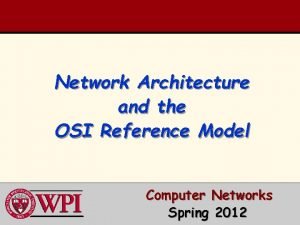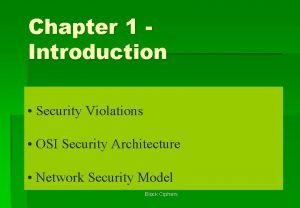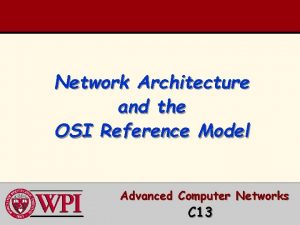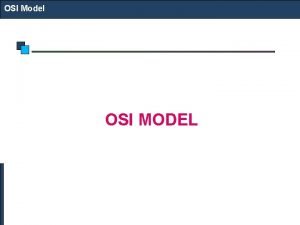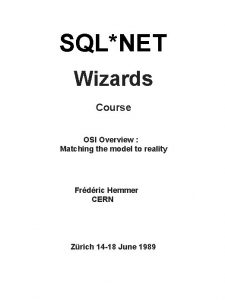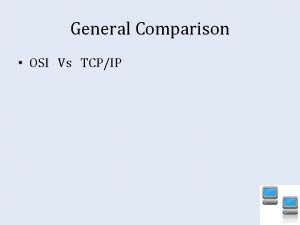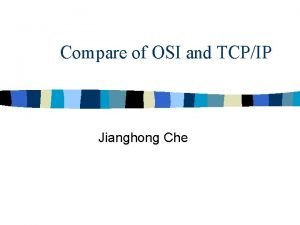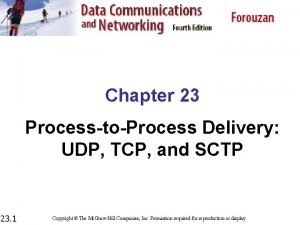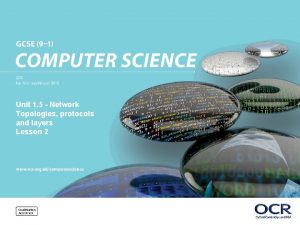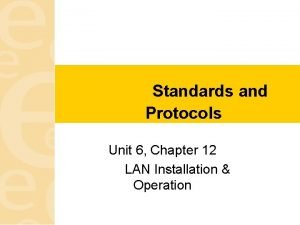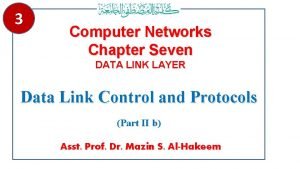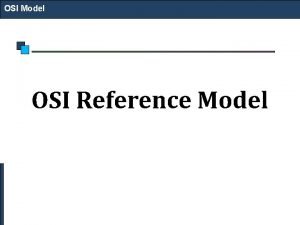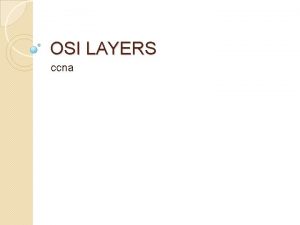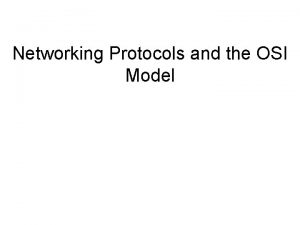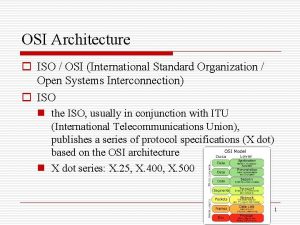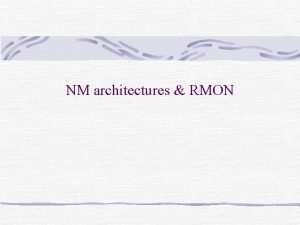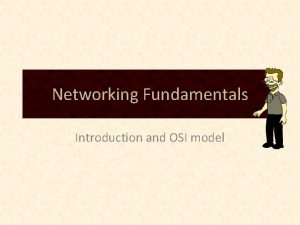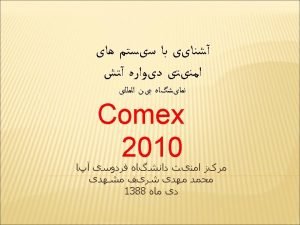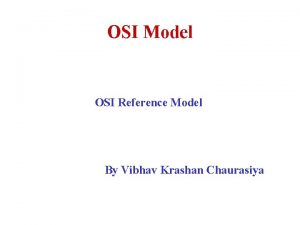Chapter 2 Protocols and Architecture Protocols OSI 7




















- Slides: 20

Chapter 2. Protocols and Architecture • Protocols • OSI 7 -layer Reference Model • TCP/IP Protocol Suite 1

Protocols • Key elements – Syntax: data format, coding, signal levels – Semantics: control information – Timing: speeding matching and sequencing • Functions – Segmentation and Reassembly, – Encapsulation, Connection Control, – Ordered delivery, Flow control, Error control, – Addressing, Multiplexing, – Transmission services 2

Functions of Protocols • Segmentation and Reassembly – Typical reasons for segmentations • Maximum size of transmitted data block • Error control may be more efficient with a smaller PDU • Shorter delay can be provided • A smaller PDU size means that receiving entities can allocate smaller buffers – Disadvantages of segmentation • The smaller the block, the greater the percentage overhead • Smaller blocks result in more interrupts • More time is spent processing smaller, more numerous PDUs 3

Functions of Protocols (cont) • Encapsulation – Control information in PDU • Address • Error-detecting code • Protocol control • Connection Control – Connectionless • E. g. Datagram – Connection-oriented 4

Functions of Protocols (cont) • Three phases ü Connection request/accept ü Data/Acknowledgment ü Terminate request/accept • E. g. Virtual circuit • Key characteristic: sequencing ü Supporting Ordered delivery, Flow/Error control • Ordered Delivery – For connection-oriented protocols – Finite sequence # field sequence # repeat 5

Functions of Protocols (cont) • Flow Control – Performed by the receiving entity to limit the rate of data that is sent by a transmitted entity – Stop-and-wait, sliding window • Error Control – Error detection based on a frame check sequence and PDU retransmission • Addressing – Addressing level, Addressing scope, – Connection identifiers, Addressing mode 6

Functions of Protocols (cont) 7

Functions of Protocols (cont) – Advantages of connection identifiers • Reduce overhead • Routing: route identification • Multiplexing • Use of state information ü End systems can enable functions such as flow/error control 8

Functions of Protocols (cont) • Multiplexing – Upward multiplexing – Downward multiplexing • Transmission services – Priority • Message basis, Connection basis – Quality of service – Security 9

OSI 7 -Layer RM • Open System Interconnection Reference Model – Layering architecture – Information hiding • Lower layers are concerned with greater details; upper layers are independent of these details – For each layer • Protocol specification • Service definition • Addressing 10

OSI Environment 11

OSI as Framework 12

Layer-specific Standards 13

Service Primitives (b) Non-confirmed 14

The OSI Layers 15

The OSI Layers (cont) • Physical layer – Mechanical, Electrical, Functional, Procedural • Data Link layer – e. g. Error detection and control • Network layer – Provides for the transfer of information between end systems across some sort of communications network (routing) • Transport layer – Provides a mechanism for the exchange of data between end systems 16

The OSI Layers (cont) • Session layer – Provides the mechanism for controlling the dialogue between applications in end systems • Dialogue discipline, Grouping, Recovery • Presentation layer – Defines the format of the data to be exchanged between applications • Data compression and encryption • Application layer – General-purpose applications are considered to reside at this layer • File transfer, Electronic mail etc. 17

TCP/IP Protocol Suite • Application layer • Transport layer – Provides end-to-end, data-transfer service • Internet layer – Routing data from source to destination host • Network access layer – Logical interface between an end system and a subnetwork • Physical layer – Tx medium, signaling rate, encoding scheme 18

TCP/IP PDU 19

Protocols in TCP/IP Suite 20
 What is the osi security architecture
What is the osi security architecture Architecture osi
Architecture osi Osi security model
Osi security model Osi network architecture
Osi network architecture Itu-t x.800
Itu-t x.800 Osi model architecture
Osi model architecture Osi network architecture
Osi network architecture Ftp iso osi
Ftp iso osi Chapter 3 network protocols and communications
Chapter 3 network protocols and communications Call and return architecture
Call and return architecture Iso/osi vs. tcp/ip
Iso/osi vs. tcp/ip Comparison and critique of osi and tcp/ip model
Comparison and critique of osi and tcp/ip model Proofs of work and bread pudding protocols
Proofs of work and bread pudding protocols Introduction to wan technologies
Introduction to wan technologies Cryptography standards and protocols
Cryptography standards and protocols Tcp and sctp are both layer protocols
Tcp and sctp are both layer protocols 5 network topologies
5 network topologies Snmp uses two other protocols -------- and --------
Snmp uses two other protocols -------- and -------- Lan standards and protocols
Lan standards and protocols Lab 4-1: routing concepts and protocols
Lab 4-1: routing concepts and protocols Data link layer protocols for noisy and noiseless channels
Data link layer protocols for noisy and noiseless channels

